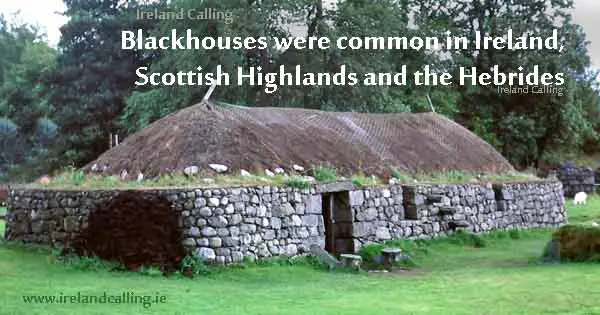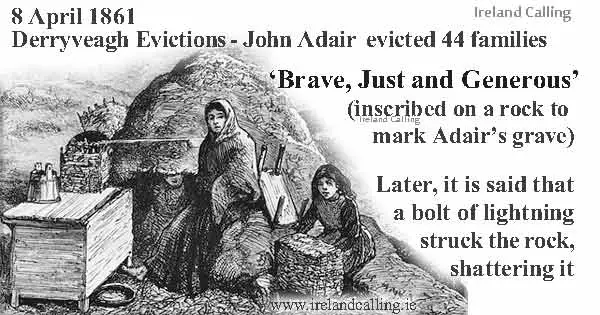Ireland was no stranger to atrocities by landlords in the 19th century, but even by the standards of those dark days, the Derryveagh Evictions were hard to surpass in terms of casual cruelty. Overnight, 244 men, women and terrified children were evicted from their homes and left to wander the roads seeking shelter wherever they could. All this was at the whim of their landlord, John George Adair, who has gone down in history as ‘Black’ Jack Adair.
It was often said that the reason for the evictions was Adair felt that the dark, dingy houses occupied by the unfortunate tenants spoilt the view from his mansion home. That may have been a factor but there was more to it than that.

Adair was taken with beauty of Co Donegal
The problem began when Adair, a land speculator of Scottish origin who owned property in Texas and in Co Laois in Ireland, visited Co Donegal in 1857. He was immediately taken with the beauty of the area and began buying land. Within a few years he had amassed an estate of about 30,000 acres.
Some of the land he acquired in the Glenveagh area was on a ‘fee-farm rights’ basis. This meant that Adair was entitled to receive rents from the tenant farmers, but he didn’t actually own the land or have sporting rights, which meant he could not use it for hunting game.
Adair wanted to build a hunting lodge, which could be used as a base for shooting parties. He then arranged a fowl shoot across land on which he did not have sporting rights. This angered tenants, who feared their crops would be damaged and their livestock disturbed.
Tenants sabotage Adair’s hunt
They set out to sabotage the hunt by beating the bushes to frighten the fowl away. They also formed a circle around Adair wherever he went, hindering his ability to hunt. He was infuriated by what he considered their impertinence and their audacity in defying him. He was said to have threatened the tenants with his gun and warned them that they would pay dearly for their actions.
Adair aquires full rights to the land
Shortly afterwards, Adair acquired full title to all the land at Glenveagh, including the area in which the tenants had defied him. This meant he could now evict them.
In 1860, he told tenants that he was considering ways to “rearrange the farm boundaries” which could result in some of them having to leave. He was keen to use the land for grazing sheep, which might provide a better return than the rent paid by the tenants.
Later that year there was another event that was to be a catalyst in the story. Adair’s land steward James Murray was found murdered on a nearby mountain. The killer was never discovered but Adair always suspected it was one of the tenants.
Mass evictions – 200 police and ‘Crowbar Brigade’
In April 1861, he decided to make his move and carry out a mass eviction. He brought in a special force of 200 police officers, several soldiers and a team of 10 men armed with crowbars to force entry where needed. All 47 families were evicted over three days between April 8 and April 10. Their homes were then destroyed. A Derry newspaper of the time carried eyewitness reports.
One said: “The family of the Widow McAward was the first to face the terror of the Crowbar Brigade. The Sheriff, accompanied by Adair’s new Estate Manager, approached the house where the poor sixty year old woman lived with her six daughters and one son and long before the house was reached, loud cries were heard, piercing the air and soon the figures of the poor widow and her daughters were observed outside the house where they gave vent to their grief in strains of touching agony.
Forced to discharge an unpleasant duty, the sheriff entered the house and delivered up possession to Mr Adair’s steward, whereupon a Crowbar Brigade of six men who had been brought from distance immediately fell to with right good will to level the house to the ground. The scene became indescribable.”
Derryveagh Diaspora
Some of the dispossessed sought refuge with their families, others ended up in the workhouse. None got their farms back and most eventually emigrated to America or Australia, becoming known as the Derryveagh Diaspora.
Even by the standards of the day it was an outrageous act. An official investigation was held, which confirmed that 244 people, including 159 children, were made homeless.
The issue was raised in the British parliament but no action was taken against Adair. In spite of his wanton cruelty, he had broken no law so there was no case against him. He remained in the area and died in 1885. His widow had a large rock inscribed in his honour with the words: Brave, Just and Generous. Local legend has it that the lightning later struck the rock, shattering it into pieces.

‘Black’ Jack Adair has since gone down in the Irish memory as one of the worst and cruellest of all tyrannical landlords.
This RTE video has a report on the commemoration of which took place on the 150th anniversary of evictions. It contains interviews with descendants of the evicted.
Glenveagh is now a National Park
In 1937, John Adair’s castle and gardens were bought by Henry McIlhenny of Philadelphia. He gave them to the Irish nation in 1981. Glenveagh in Co Donegal is now the second largest national park in Ireland. It homes the Derryveagh mountains including Mount Errigal and The Poisoned Glen. It has the largest herd of red deer in Ireland
Thousands of tourists visit here every year. It is one of the areas of outstanding beauty in Ireland.

history.html